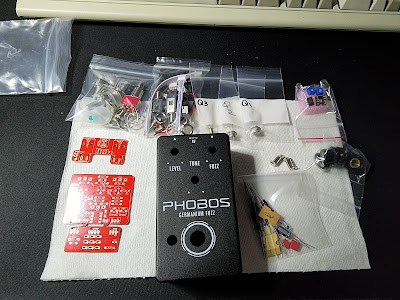JP's Gear Review v2.0 - Ep. 1 - AionFX Phobos Germanium Fuzz
As I mentioned in a previous post, I purchased an AionFX Phobos kit. I received it earlier this week, but I was still waiting on some extra parts. Since the Telefunken AC116 transistors I ordered are most likely coming in from Germany by crossing the Atlantic on a dinghy, I went ahead and used the transistors included in the kit.
The parts
 |
| The parts came neatly packaged in different bags. |
The kit came very well packaged, and arrived in about one week from the US. The quality of the every part is top-notch.
PCB
The PCB is really well designed. It's a simple 2-layers PCB, red in color. The kit includes two PCBs:
- the Tone Bender circuit itself with a breakaway part for the 3PDT switch
- a small board to host the DC jack and input/output jacks
Each board is designed to use 3-strands and 4-strands wire assemblies (with the appropriate headers included) to connect to each other. This minimizes the spaghetti-wiring potential.
I have only two small issues with the PCBs:
- The spacing between resistors leads is just a hair too small for most resistors. They don't lie completely flat since one lead needs to slightly curve inward to fit in.
- The space around the 3PDT footswitch is too tight. Unless you use a small form factor 3PDT footswitch, which are not that readily available, you might have some difficulty fitting the board to the footswitch since the 4-strands wire assembly might be in the way.
Other than these two small issues, it's one of the best board I worked on so far.
Passive components
The resistors look really nice. They are 0.5% tolerance and are fancy enough to have their value printed on them with numbers and letters instead of the typical colored bars. They are coated with red... resin? epoxy? Well, they are coated with red something, they match with the PCB, and I really dig the clean look it results in.
The film box capacitors are red WIMA 5% tolerance, with some blue Kemet, depending on availability. Electrolytics are Nichicon, and I could not figure the brand out from the two MLCC capacitors.
There were - as expected - no branding on the diodes, but they look exactly like the ones you can find from Mouser, Digi-Key, or Tayda Electronics. They work just as well.
I couldn't figure out what brand the potentiometers were, but they seem to be on par with the Alpha I normally use. The two bias trimmer potentiometers are Bourns, as the stylized "B" logo is clearly visible in the top right.
The input and output jacks are stereo PCB-mounted enclosed jacks. No branding was visible on them, but they look and feel sturdy. Same goes with the DC jack.
The 3PDT footswitch looks like a compact Dailywell. It has a very low actuation force and is quite pleasant to use.
Active components
The only IC present is a TC1044SCPA charge pump so the pedal can be powered from the same center-negative power adapter as any other pedals (otherwise you get noise down the power line and it can affect other pedals on the same power chain). From the markings, it is a genuine Microchip Technology/Atmel IC.
The transistors are NOS (new-old-stock) since new germanium transistors are only available for some very specific industrial applications and are quite expensive. The ones included in my kit were Russian/Soviet-made MP16A and MP25A for Q1 and Q2, and one AC116 of unrecognizable branding for Q3. They had the following hFE (hybrid parameter forward current gain, common emitter) values:
- Q1: 52.5
- Q2: 53.9
- Q3: 80.5
Since I plan on changing them and I didn't want to solder them in place, I purchased some TO-5 transistor sockets from Digi-Key. Super useful and not that expensive. It's a good upgrade for all circuits where you might want to experiment with different transistors.
The enclosure
The enclosure have neither Hammond Manufacturing nor Eddystone markings in it. There's only a big "B+" molded in the back cover. It looks as solid as any other aluminium enclosure out there. The paint job on it great. It's some sort of matte, black, barely textured paint, with nice white labelling. The paint is really well done and doesn't chip easily. The I/O and DC jacks are top-mounted, like the original Tone Bender.
Assembly
The assembly is pretty straightforward. The instructions are clear are easy to follow, and the drawings and diagrams are well done. The assembly guide is hefty at 31 pages but it's very complete. A beginner can follow these steps and assemble a functioning unit. Assembly time is about 1h when taking your time. The finished product looks great. The red resistors and PCB are really neat. The transistor sockets give it a nice look as well as making the pedal easy to modify:
 |
| The PCBs are snug and everything fits nicely. |
Sound
It sounds great. The recommended bias of 3.5V for Q1 and Q2, and 2V for Q3 is just about perfect. The pedal is able to generate very light, barely perceptible fuzz as well as heavy dirt. The tone control is OK, but a bypass toggle would have been a great addition to the circuit. It sounds awesome on bass, too!
Light-ish fuzz demo:
Heavy fuzz demo:
Summary
It is, by far, the best kit I have ever assembled. The price point is not exactly cheap, but it's not too expensive either, and it's 100% worth it. They have a bunch of other kits and PCBs with prices starting from 12$US for a PCB and up to about 94$US for a full kit. I will definitely get a few more of their stuff in the near future. The enclosures really stand out by their simple and elegant design.
The All-Important Rating™
Build quality: 15/10 (Well, I guess it depends on your skills as a builder, but the parts are really good.)
Kit quality: 9/10 (Docked one point because the resistor spacing is a hair too small and for not including transistor sockets.)
Effect quality: 10/10
Ease of use: 10/10 (It's a standard 3-knobs fuzz, not a 5-knobs Fuzz Factory)
Retro-cool elegance: 10/10





Comments
Post a Comment